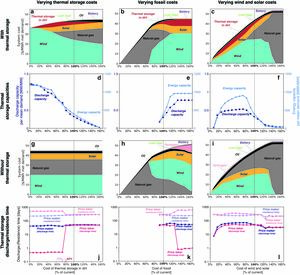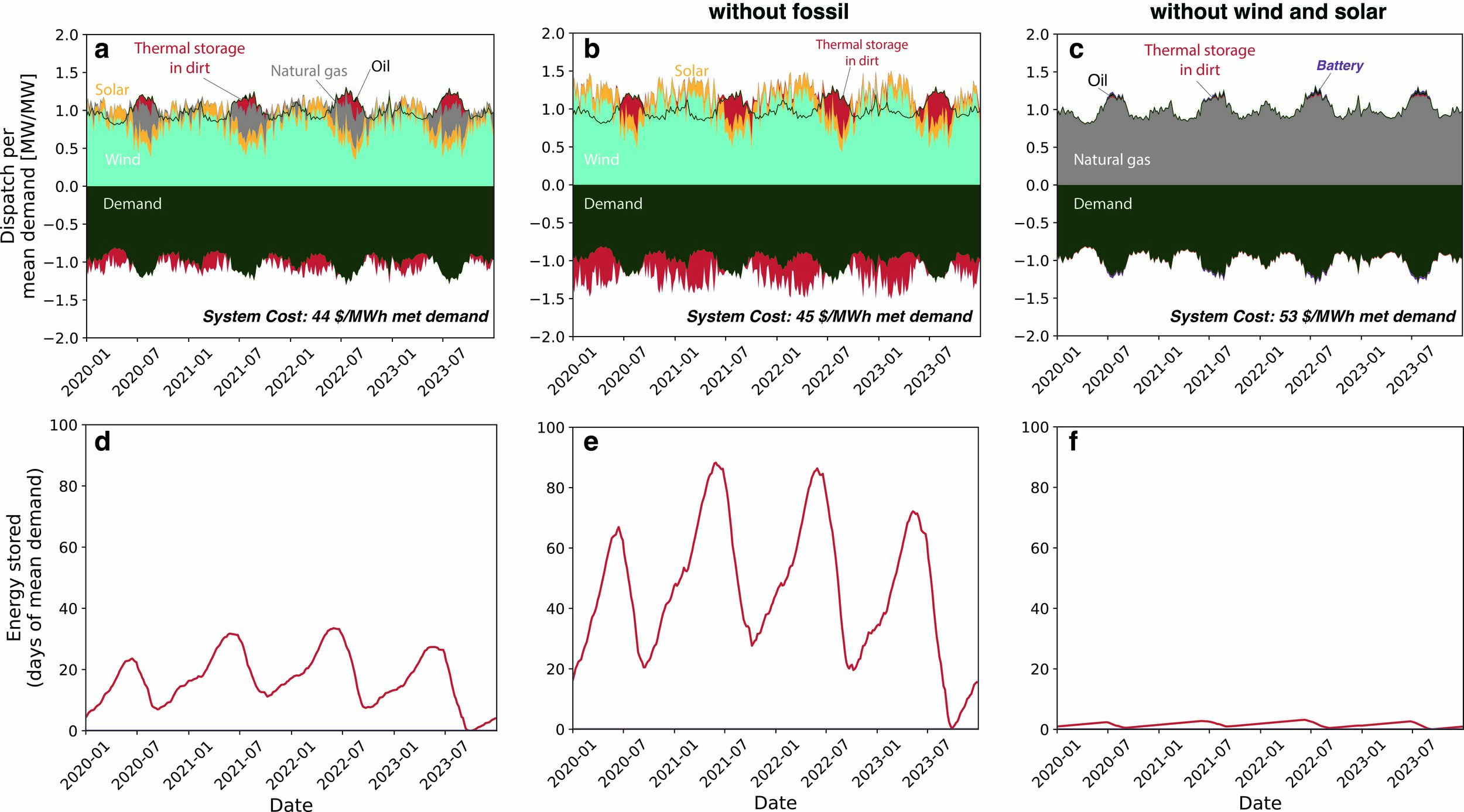1. Questions
Dirt is an excellent thermal storage medium due to its low thermal conductivity, which limits heat transport to a few meters per year (Zeng, Cheng, and Yang 2024, see SI for details). Thermal energy storage in unconsolidated rocky material (hereinafter referred to as thermal storage in dirt) uses the earth as a storage medium and is thus characterized by very low energy capacity costs,[1] consisting only of the cost of embanking dirt fill on-site, under the assumption that locally available dirt is used ($0.01/ SI Tab. 1); however, it has a low roundtrip efficiency. In contrast, Li-ion batteries, for example, have high energy capacity costs (about $100/ optimistically, SI Tab. 1), which limits their cost-effectiveness despite their high roundtrip efficiency (Tong et al. 2020; Jenkins and Sepulveda 2021).
Repowering the steam turbogenerators of decommissioned coal plants with energy storage technologies may offer a viable approach for extending the utility of existing infrastructure (Millet 2023; Qvist et al. 2020). Between 2025 and 2030, approximately 50 of coal plant capacity will have reached their typical life span of about 50 years and are expected to be retired (Grubert 2020; Tyson Brown 2022).
In this study, for electricity systems reliant on wind and solar and/or fossil generation, we address the following questions:
-
Under which cost conditions could storing heat from thermalized grid electricity in dirt become cost-effective to repower decommissioned steam turbogenerators?
-
How would least-cost energy-to-power ratios differ between when thermal energy storage first enters a market and reacts to electricity market prices, versus when it reaches market equilibrium and influences market prices?
2. Methods
We define a parsimonious one-node model of the contiguous United States electricity system. We model least-cost systems using PyPSA (Brown, Hörsch, and Schlachtberger 2018) optimized over a four-year period at hourly timesteps, taking into consideration the cost factors listed in Supplemental Information (SI) Table 1. We use wind and solar generation capacity factors obtained with atlite (Hofmann et al. 2021) and hourly electricity demand (Ruggles et al. 2020; Ruggles, Wongel, and Farnham 2025) based on U.S. Energy Information Administration data. In this work, “current costs” for all technologies refer to cost estimates by Orca Sciences (SI Tab. 1). Because our focus is on thermal storage used to repower decommissioned steam turbogenerators, we consider costs of discharging from the thermal energy storage in dirt to the turbogenerators, but not the cost of the turbogenerator itself. The modeled electricity system considers natural gas, oil, wind, and solar generators, and underground hydrogen storage, lithium-ion batteries, and thermal storage in dirt.
We compare the value of the thermal storage in dirt in two different model configurations (Fig. 1): price maker and price taker (Goteti, Hittinger, and Williams 2019). At market equilibrium, thermal storage in dirt acts as a price maker and contributes to setting market prices. However, when a technology is newly introduced into an electricity system, it contributes a marginal amount of electricity to the system and acts as a price taker reacting to market prices. We obtain the cost of electricity for the price-taker cases from the least-cost system without thermal storage in the corresponding price-maker case (SI Fig. 2).
We assess how varying the costs of thermal storage in dirt influences its role in the system. In the main text, for simplicity, all costs related to a technology (e.g. power and energy capacity costs, fixed and variable costs) are scaled simultaneously by the same factor.
Model codes and analysis results are publicly available (Wongel 2025a, 2025b; Wongel, Hayes, and Caldeira 2024).
3. Findings
We find that, in the price-maker case with all technologies at current costs, the majority of electricity is supplied by wind generation, with natural gas and thermal energy storage in dirt providing electricity primarily to meet seasonal residual demand challenges posed by wind lulls and concurrent demand peaks (Fig. 2a, d). When natural gas and oil (referred to as ‘fossil generators’) are excluded from the system, the dispatch of electricity from thermal storage in dirt increases by about a factor of three (Fig. 2b, e). When wind and solar generators are excluded from the system, the dispatch of electricity from thermal storage in dirt decreases by about a factor of nine relative to the reference case (Fig. 2c, f). Repowering decommissioned coal plants with thermal storage in dirt could reduce the need for oil peaker plants. As the share of electricity supplied by wind and solar generation increases in the model, seasonal residual demand challenges are increasingly met with thermal storage in dirt.
The role played by any technology in a least-cost system depends on its own cost and performance characteristics, as well as the roles played by other technologies in the system.
In model simulations for the price-maker case, thermal energy storage in dirt influences market prices, and its capacity is at market equilibrium. In this case, low capacity costs of thermal storage in dirt (Fig. 3a) lead to substantial discharge power and energy capacities (Fig. 3d).
The price-taker case assumes that the capacity of the thermal energy storage in dirt is vanishingly small relative to market demand, and thus does not influence market prices. At thermal storage costs below about 75% of current costs, the system stores heat whenever electricity costs are low and discharges large amounts of energy in the several hours per year when electricity costs are highest (SI Fig. 2d). Rapid discharge allows the storage operator to hold more energy until high price arbitrage opportunities arise, leading to an increase in residence times of stored energy (Fig. 3j). At higher thermal storage costs, oil cost-effectively contributes to meeting the more extreme residual demand peaks (Fig. 3a), and thermal storage in dirt takes advantage of many smaller price arbitrage opportunities (SI Fig. 2d).
Thermal storage in dirt still competes in least-cost systems when modeled with a $500/ discharger cost, which represents a costlier steam turbogenerator retrofit (SI Fig. 4).
Increasing fossil costs lead to substantial increases in discharge power and energy capacities of thermal storage in dirt (Fig. 3b, e). At wind and solar capacity costs below about 30% of current costs, larger capacities of wind and solar reduce thermal storage use (Fig. 3c, f). At wind and solar costs above about 80% of current costs, electricity generation is increasingly provided by fossil generators (Fig. 3c, f).
In price-taker cases, electricity costs depend on the costs of the other technologies operating in a system without thermal storage in dirt (Fig. 3h, i). In these cases, at high fossil costs, hydrogen can cost-effectively meet peak demand, driving the total electricity system cost (Fig. 3h). This competition creates a few large price arbitrage opportunities for thermal storage in dirt (Fig. 3k), with low discharge times (i.e. energy capacity divided by discharge power capacity) analogous to low thermal storage costs (Fig. 3j). Discharge times remain similar in price-taker and price-maker cases when wind and solar costs vary, as the price arbitrage opportunities remain relatively stable because extreme demand peaks are met with oil (Fig. 3i).
At current costs, thermal storage in dirt could leverage many small price arbitrage opportunities (Fig. 3j). If costs of thermal storage in dirt were to substantially decrease or the cost of fossil generation were to substantially increase, then, when first entering a market, it could take advantage of a few large price arbitrage opportunities (Fig. 3j, k).
We find that, in systems reliant on wind, solar, and natural gas generation, thermal storage in dirt used to repower decommissioned coal plants could play a substantial role in meeting seasonal demand peaks at current costs. The value of thermal storage in dirt increases with reduced reliance on fossil generation and greater wind and solar integration (Fig. 2).
Acknowledgements
AW, JD, and LD acknowledge financial support from a gift by Gates Ventures to Carnegie Science. AW also acknowledges financial support from Orca Sciences. We thank Steven J. Davis for valuable comments and assistance with visualization. We thank Leslie Willoughby for insightful editorial suggestions.
Energy capacity cost is the capital cost to install storage infrastructure per unit of energy capacity. It reflects the ability to store energy, not the cost of energy delivered. All other costs related to the equipment necessary for the operation of the thermal energy storage, such as heaters and pipes, are included in the charger and discharger capacity costs.

_price-maker_case.jpg)


_price-maker_case.jpg)

